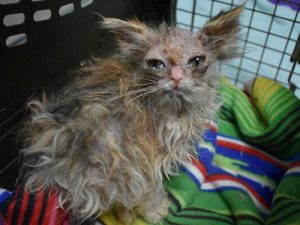Skin issues are one of the most common, and often challenging, health problems that affect our pets.

While all that itching and licking may seem annoying to us, it can be extremely uncomfortable for animals. “I don’t think people really appreciate how stressful skin problems can be for our pets,” says Dr. Stephen Kochis, OHS Chief Medical Officer. “An untreated skin condition can leave an animal in a constant state of pain.”
Skin problems is a broad term that covers everything from allergies to infections to chronic conditions. And diagnosing and treating irritated skin can be a complicated and frustrating process. “Understanding your pet’s skin and working with your veterinarian to treat and prevent problems is key,” adds Dr. Kochis.
We asked Dr. Kochis for advice and answers to the most frequently asked questions.
Q: What are the most common skin issues for cats and dogs?
Fleas/flea allergy dermatitis is the most common skin problem for cats and dogs. Pets are more vulnerable when you don’t remember to give them preventatives that are prescribed by your vet. The other common skin issue is atopic skin disease, or environmental allergies, and food allergies.
Q: How to most skin problems present? For example, is itching the most common symptom?
Allergies typically cause itching, licking and scratching which leads to inflammation which compromises the normal skin barrier allowing more allergens in and setting the stage for secondary skin infections. Skin infections cause more inflammation/itch and the cycle continues.
Staphylococcus (bacteria) and Malassezia (yeast) are the most common pathogens associated with superficial skin infections. Both organisms live on the skin in healthy pets and do not usually cause issues. It’s important to remember that itch can come in the form of scratching, rubbing parts of the body on the ground/objects, and licking. Hair loss, crusts/flaking, odor, redness and pigmentation changes are also common.
Q: What kinds of skin issues can be resolved, and which ones are chronic?
Most allergies are chronic but can be managed by diligent owners and veterinary teams. The best chance for success in managing allergies is early intervention. Find out what the pet is allergic to and prevent the allergen from entering the body. You could also consider allergy shots. Identify and treat any parasites (fleas, mites) followed by regular preventatives. Make sure that you treat any infections until they are completely resolved. Manage your pets itching and inflammation to prevent further infection.
Q: What kinds of treatments are available?
In the last 10 years, science has given us true game changers in the treatment and management of skin allergies. Apoquel is an immune system modulator that targets specific inflammation causing cell signals. Cytopoint is a monthly injection that specifically blocks the chemical that triggers itch. There are also numerous topical therapies and shampoos that treat infection, wash allergens from the body and strengthen the skin barrier. The earlier we intervene in a dog’s life the better the chances of controlling the allergies. Safe, orally-administered monthly parasite preventatives are also helpful. It’s important to discuss your pet’s specific needs with your veterinarian before determining a course of treatment.
Q: Are there certain breeds that are most susceptible to skin problems?
Many breeds of dogs that have a genetic predisposition to allergic skin disease. There are also breeds with wrinkles that provide dark, moist environments for bacteria and yeast to grow.
Q: What is the most challenging part of treating skin issues in a shelter environment?
Many of these patients require daily medications, frequent bathing, and extensive diagnostics to rule out and treat secondary problems like parasites, infection, and endocrine disease (like hypothyroidism) that can complicate response to therapy. It’s very difficult to do a true food trial in the shelter with so much access to treats and food that might not be on the pets diet plan. Many of the dogs we see are also chronically affected and require skin biopsies, full lab work, and consultation with a dermatologist.
We are very lucky at OHS to have specialists in the community who donate their time to consult on the more challenging cases, especially Dr. Sonja Zabel. We are also lucky that we have generous donors that provide resources for us to have many of the very best treatments on the market.
Q: What can pet owners do to protect their pet’s skin?
Seek the care of a vet if your pet is having issues. The skin is the largest organ system in the body. So, if it is inflamed, infected and itchy it can really affect the quality of life of the pet.

Gremlin’s Journey
Gremlin’s name suited her since she didn’t even look like a kitten when she arrived at OHS. Her tiny body was covered in a skin fungus called ringworm.
After months of medication and special baths, Gremlin has transformed. Luckily, ringworm is not a chronic condition so Gremlin’s beautiful new coat should continue to shine in the years to come.
She was adopted by her dedicated foster parent who was an important part of Gremlin’s recovery.


